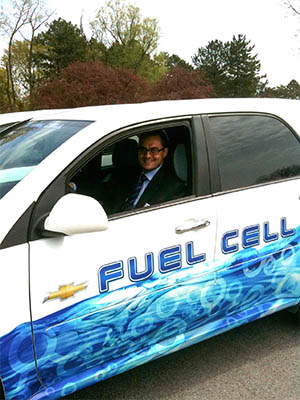
This summer, Dr. Yossef Elabd, professor in the Artie McFerrin Department of Chemical Engineering at Texas A&M University, was awarded two new National Science Foundation (NSF) grants for integrating polymers into electrochemical devices, most notably fuel cells.
Elabd, associate department head, director of the undergraduate program and recently appointed holder of the Joe M. Nesbitt Professorship, is single principal investigator (PI) on the two grants, and he received a third NSF grant as a co-PI with Dr. Costas Kravaris as PI, also a professor in the chemical engineering department.
Elabd’s research focuses on the main incentive for fuel cell research, which is to apply the technology to vehicles. While there are numerous benefits to using fuel cells in vehicles, as opposed to the now standard battery powered vehicles, one stands out. According to Elabd, “The main benefit of the fuel cell is that the energy density is just so much higher than a battery - six times higher.”
In a nutshell, a fuel cell produces electric energy directly from an electrochemical reaction between hydrogen and oxygen. Fuel cells use positive and negative electrodes, anodes and cathodes respectively, to move protons through an electrolyte polymer, converting the chemical fuel directly into electrical energy. Currently, the electrodes in fuel cells are primarily composed of platinum.
Platinum is one of the most expensive commodities on earth. The price of platinum is one of the primary limiting factors for the adoption of fuel cell technology. The two NSF grants will allow Elabd and his research group to look for a way around the platinum bottleneck.
The first grant “Nanomanufacturing of Three-Dimensional Nanofiber-Nanoparticle Electrodes for Ultra-low Platinum Fuel Cells,” aims to dramatically reduce the use of platinum in fuel cells. This grant will help Elabd further develop a new electrode manufacturing process. This process consists of electrospinning polymer fibers and electrospraying a catalyst to create a new nanofiber-nanoparticle electrode. These new electrodes currently produce nearly the same power density as the current standard electrode while using only around 16 percent the amount of platinum. This new grant will target reducing this platinum amount even further.
 The second grant “Polymerized Ionic Liquid Multiblock Polymers as Anion Exchange Membranes for Alkaline Fuel Cells,” will build on Elabd’s research toward developing a novel class of fuel cell electrolytes. On the whole, the chemical structure and makeup of a fuel cell is determined by the electrolyte. Currently there are relatively few proven electrolytes, which limits the flexibility and variety of every other component of the cell. However, using polymerized ionic liquids as the electrolyte opens the door to the use of a wide variety of different chemistries in fuel cells, which also provides the ability to remove platinum completely from the equation.
The second grant “Polymerized Ionic Liquid Multiblock Polymers as Anion Exchange Membranes for Alkaline Fuel Cells,” will build on Elabd’s research toward developing a novel class of fuel cell electrolytes. On the whole, the chemical structure and makeup of a fuel cell is determined by the electrolyte. Currently there are relatively few proven electrolytes, which limits the flexibility and variety of every other component of the cell. However, using polymerized ionic liquids as the electrolyte opens the door to the use of a wide variety of different chemistries in fuel cells, which also provides the ability to remove platinum completely from the equation.
While fuel cell vehicles may not currently have the same popularity as battery-powered electric vehicles, advancements in research that reduce cost could change all this because fuel cells have six times higher energy density compared to batteries, and vehicles with fuel cells are not limited by weight constraints, the same constraints that dramatically limit the range of current electric battery vehicles.